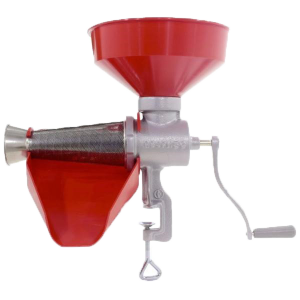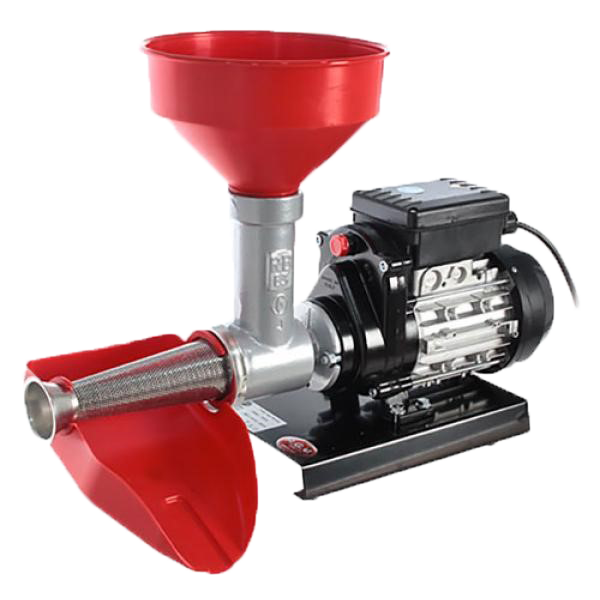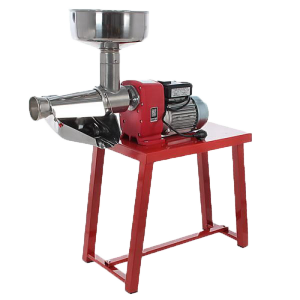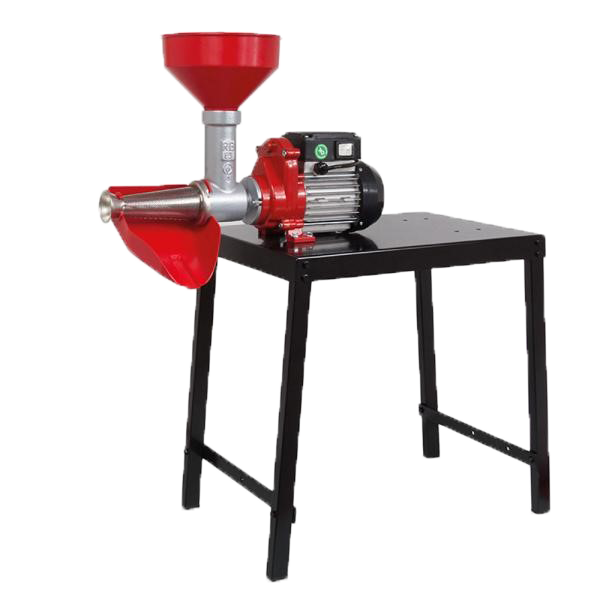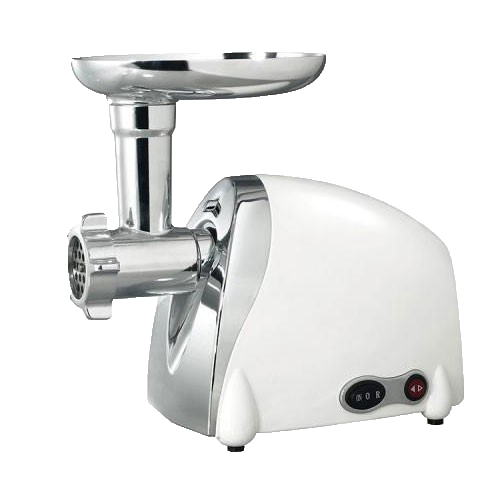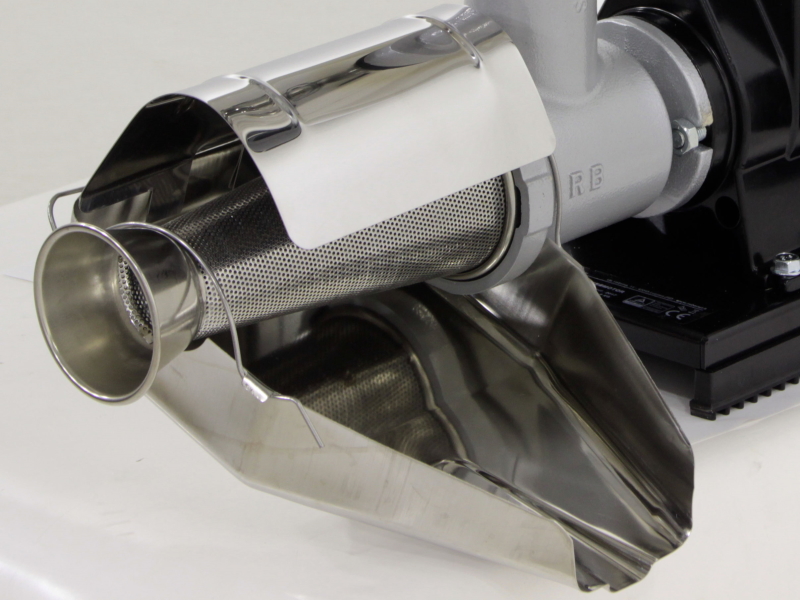A comprehensive guide to purchasing tomato presses, with a review of the existing types, in order to provide information on which one is best suited to your needs.
The Complete Guide to help you choose the Best Tomato Press
by the Real Experts of Kitchen Equipment
Making tomato sauce is an Italian tradition that is carried out every year at the beginning of summer. Despite the fact that every supermarket is now stocked with all kinds of tomato sauce, many families still prefer to make their own at home, and the perfect tool to this purpose is the tomato press, the features and functions of which will be discussed in more detail below.
Contrary to what one might think, the number of people trying their hand at homemade tomato sauce is ever increasing. This is due to a growing need for genuineness and authenticity in food, and to the consumers’ greater interest in organic and zero-mile products.
In this purchasing guide we will talk about the different types of machine for tomato sauce in order to provide useful information to understand which one is the best tomato press for your needs.
CONTENTS
1. Tomato presses: an introduction
The tomato press, also known as tomato squeezer is the machine that allows you to transform tomatoes in tomato sauce directly at home and with great ease. Years ago, tomato squeezers were really heavy and bulky tools that had to be stored in the cellar or the garage. There are now a number of different types and models, and they are compact and lightweight machines, which can be stored directly in the kitchen without taking up too much space, whether hobby or professional level machines.
2. How to use the tomato press

Tomato presses are very easy to use. Their function is to separate the tomato pulp from the skin and seeds. A great advantage lies in the fact that the tomato squeezer does not require any manual intervention beforehand on the product, thus saving the user time and effort. Obviously, before processing the tomatoes, it is always a good idea to wash them thoroughly and remove any green parts. For the tomato sauce, it is advisable to use “plum tomatoes ”, which are rich in pulp and have an elongated shape.
Generally speaking, these machines are fairly easy to use and can produce a dense and tasty tomato sauce. The final product must be stored properly in glass jars and then used either raw or in cooked, elaborate dishes.
3. Electric or manual tomato presses?
Electric tomato presses are now widely available on the market and are naturally more practical than manual ones. Yet the latter are still in high demand among buyers as they are suitable for those who have to produce a rather limited amount of tomato sauce. So which tomato squeezer to choose?
- Manual tomato press
Manual tomato presses, also called hand crank tomato squeezers, allow the extraction of tomato pulp by hand.
They are not equipped with a motor, but have a crank that when turned will rotate the impeller and press the tomatoes.
This method is easy to apply, but is of course more tiring than electric models, which is why it is recommended for those who have to produce small quantities of tomato sauce.
At the same time, however, hand crank tomato squeezer offer other advantages: they are particularly cost-effective and lightweight, easy to handle and take up very little space.
They are usually very simple-designed products and do not have the additional features that an electric tomato squeezer can have, but they can easily meet the needs of a family that wants to produce its own tomato sauce at home.
- Electric tomato press
Electric tomato presses are certainly the most popular on the market today. These tools are obviously easier to use than manual models and reduce user fatigue. The electric motor allows to produce a considerable amount of sauce in a short time.
The motor rotates the impeller quickly and allows the separation of pulp from skin, seeds and general waste. These tomato presses can process both fresh and blanched tomatoes, with the former resulting in a more liquid tomato sauce and the latter in a thicker, more homogeneous product. Blanching the tomatoes allows the water to be released from them.
Electric tomato presses can come with different technical and structural characteristics. Very often, electric tomato squeezers have a metal body with a more or less powerful electric motor. The power of the motor determines the hourly output of the tomato squeezers, which is perhaps the most significant technical feature of these tools as it indicates their production capacity.
A powerful electric motor not only guarantees a high hourly output, but also longer work sessions. It is therefore correct to say that a tomato press with a motor power of around 300 Watts stands out for a good performance in the range of hobby tomato squeezer, but the power increases significantly in semi-professional or even professional level products.
4. Electric tomato presses: tabletop or with bench?
Tabletop electric tomato presses and tomato presses with bench belong to the same family but have considerable structural differences.
The main difference lies in the size. Table-top electric tomato presses are considerably more compact and smaller in size. They are equipped with support bases that allow them to be placed on any kitchen table or cabinet. It is important that the product is stable and firmly fixed to the surface when processing tomatoes.
Tomato presses with bench are equipped with a small table attached to the machine body and are therefore placed directly on the floor. These are larger models and are suitable for people who need to make a large amount of tomato sauce. Also of this type there are models ranging from hobby to professional levels. They feature both a metal body and bench.
The tomato squeezer with bench is basically chosen for reasons of comfort or to meet user’s habits.
A tabletop tomato press needs to be placed a little higher to allow the tomato sauce to be poured into an ordinary bowl. These tomato presses feature a machine body made in die-cast aluminium, the propellers are in food-safe resin, while other components – such as the chutes and the chute shields – can be made in food-grade plastic or stainless steel. Depending on the level
of the tomato squeezer, the hourly output can range from 50 to 200 kg/h for
hobby models and from 100 to 460 kg/h for heavy-duty models.
Whereas this is not necessary with a tomato press with bench, as the bench has just the right height to easily place a bowl under the machine to collect the tomato sauce. Furthermore, tomato squeezers with bench obviously do not need a table as a support base, although nothing prevents the user from placing them on it. In terms of technical and functional characteristics, there is no difference between a tabletop tomato squeezer and one with bench: an average tomato press will perform the same job as a tabletop machine of the same level.
Why choose one or the other?
The real difference lies in the fact that tabletop models of tomato presses on the market can come in all three quality categories:
- Hobby level
- Semi-professional level
- Professional level
While in the case of tomato squeezers with bench, only semi-professional and heavy-duty models can be found.
5. The structure of a tomato press
A tomato squeezer basically consists of 3 parts:
- The motor
- The transmission
- The accessory (on which the hourly output of the tomato press depends)

The motor 
The transmission 
The accessory
5.1 The motor
There are two types of motors:
- brushed motor (normally fitted to cost-effective models)
- induction motor (typical of semi-professional and professional products)
The induction motor works by creating a temporary magnetic field that repels and attracts permanent magnets. This generates force which is converted into shaft rotation. In brushed motors, there are brushes inside the motor and they are used to supply current to the windings. Brushless motors have none of these commutators. The windings are on the rotor for brushed motors and on the stator (the fixed part of the motor) for brushless motors. By placing the windings on the stationary and external part of the motor, there is no need for brushes.
The advantages of a brushless motor are:
- longer service life, there are no brushes that wear out
- less maintenance, no brushes to replace
- higher performance
The induction motor is therefore more performing, sturdier and more efficient than a brushed motor. A tomato press that mounts a brushless motor is recommended for high hourly output of sauce, whereas a brushed motor results in low production. But how can you immediately distinguish between a tomato squeezer with a brushed or induction motor?
- Tomato presses with a brushed motor usually have a plastic body to protect the motor
- In tomato presses with an induction motor, on the other hand, the motor is uncovered, which means that the fan and the piston rings are visible
5.2 The transmission
The other fundamental component of a tomato squeezer is the transmission which can be:
- direct
- belt-driven
- with gears
Hobby level tomato presses, which are fitted with a brushed motor, have no transmission (or direct drive), and the accessory is therefore connected to the motor body.
Tomato squeezers featuring a belt drive are essentially semi-professional level products. The belt-drive is the less expensive method of connecting an induction motor to a medium quality accessory.
Professional level tomato presses feature a gearbox with gears, undoubtedly the best solution, combined of course with induction motors.
5.3 The accessory and the other parts of the tomato press
The third fundamental component of a tomato squeezer is the accessory, which is conventionally divided into:
- mini (brushed motors)
- 3 (semi-professional level – induction motors)
- 5 (professional level – induction motors)
This technical element determines the machine production. The higher the level of the product with which the accessory is associated, the greater the machine output. The quality of the accessory may vary according to the manufacturer and the material with which it is made. A stainless steel accessory will be of superior quality compared to an aluminium accessory.

The tomato press is a simple-designed product but has many elements:
- Funnel/hopper: in the upper part of the machine there is a plate, which has the shape of a funnel, where the tomatoes to be passed are placed.
- Impeller: perhaps the most important component of the tomato squeezer. This is the element that crushes the tomatoes and rotates to extract the pulp and separate it from the skin and waste. The impeller is generally made of cast iron or stainless steel in professional level products.
- Filter cone: which acts like a sieve for the tomato squeezer. The impeller pushes and crushes the tomato pieces on the filter cone, and this, through its holes, releases the juice and the sauce, separating seeds and skins. Like the impeller, the filter cone can also be made of cast iron, stainless steel or thermoplastic for limited to hobby level products.
- Drip tray: this element is the container inside which the tomato sauce is collected. Some models instead of having a drip tray have a pan or spout to empty the sauce directly into bottles or jars.

Funnel hopper 
Impeller 
Filter cone 
Drip tray
In some tomato squeezers, it is possible to find a tray in which to put the skin and seed waste.
6. The other features of the tomato press
There are tomato squeezers models on the market that can perform additional functions. These are the so-called multitool electric tomato presses. In addition to making the classic tomato sauce, these models can also perform other functions and are undoubtedly the most versatile tomato squeezers on the market.
In fact, a multitool tomato press can carry out up to 4 extra functions and, by purchasing the special kits sold separately, can turn into:
- Meat mincer
- Pasta press
- Cheese grater
- Dough mixer
More commonly found are 2 in 1 machines, which can therefore perform two functions (in addition to tomato squeezing). The two most common additional functions are:
- Fruit and vegetables squeezing
- Meat mincer
Regarding the first function, it must be said that no additional accessories are needed. Indeed, several models are equipped with an impeller that can process vegetables other than tomatoes.
For grinding meat, in the other hand, a special attachment is required. This can be supplied directly with the tomato press, otherwise it must be purchased separately.




